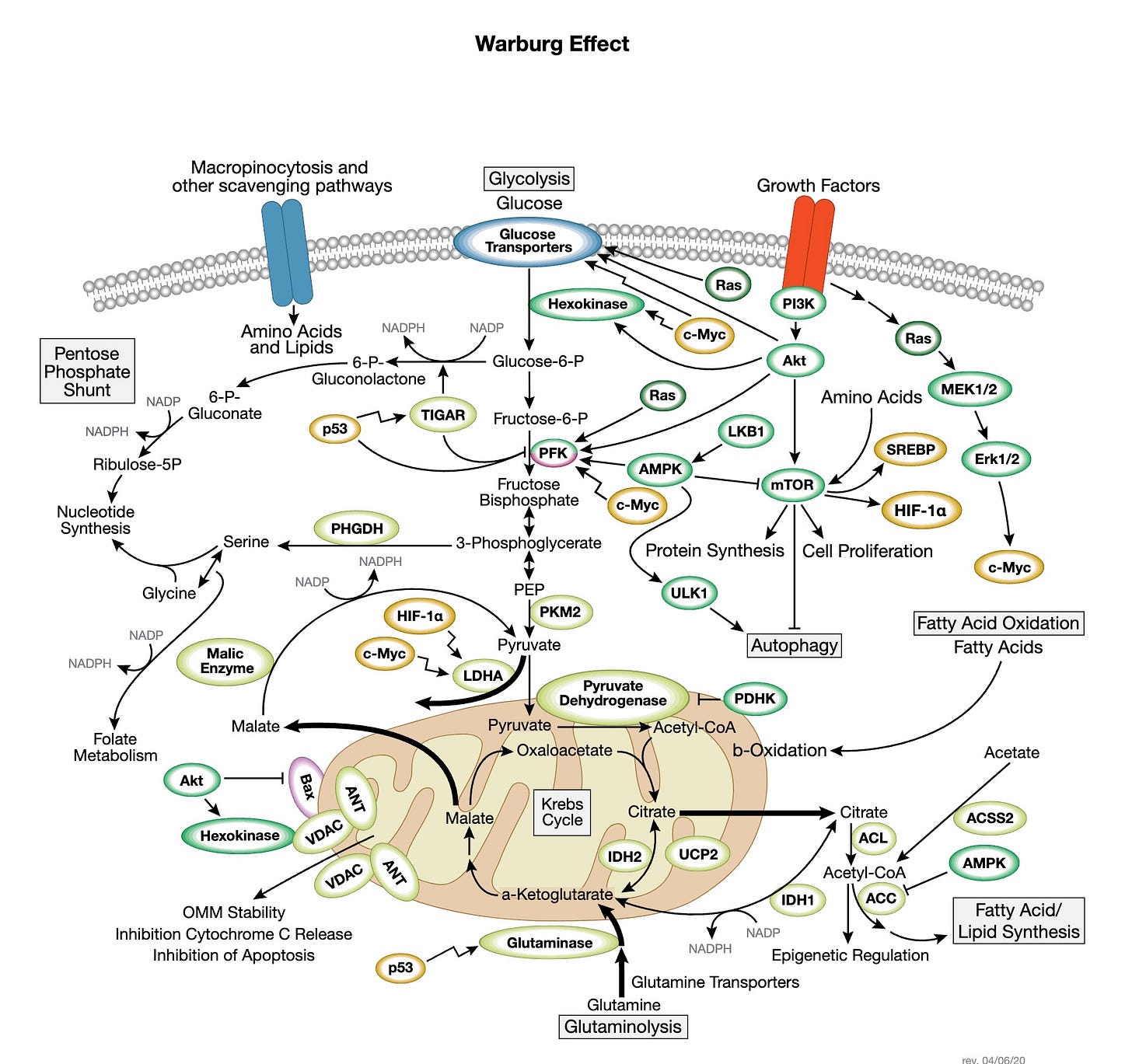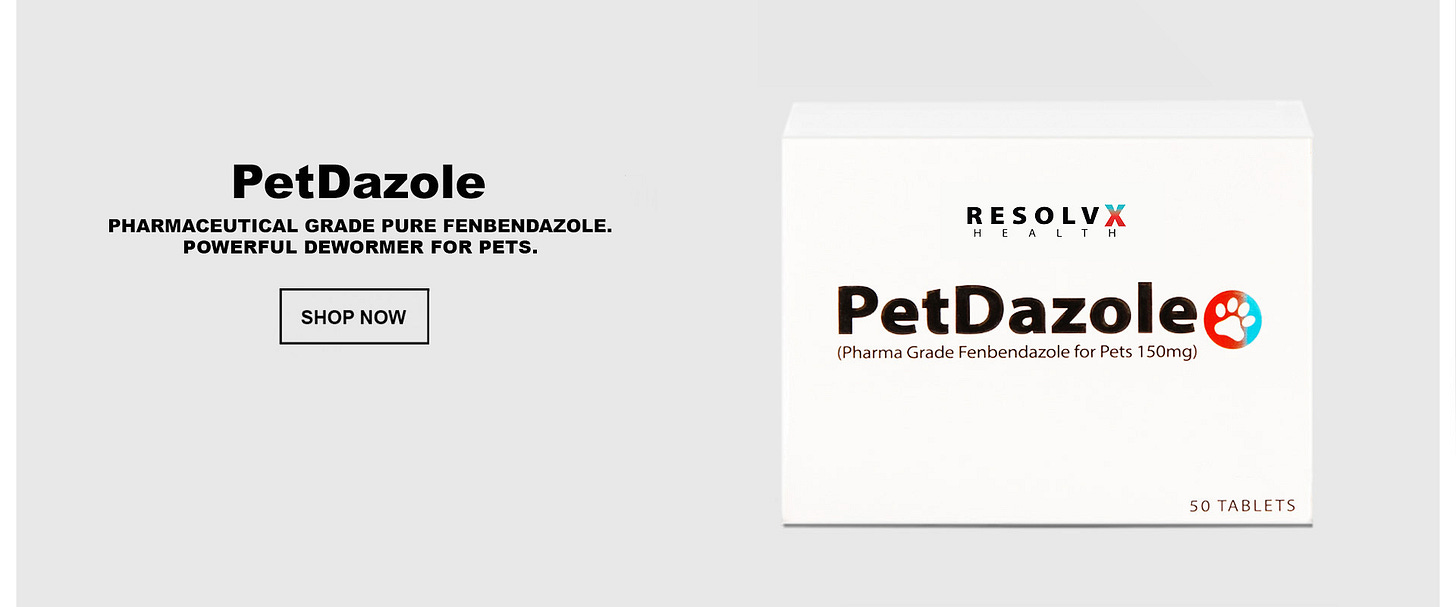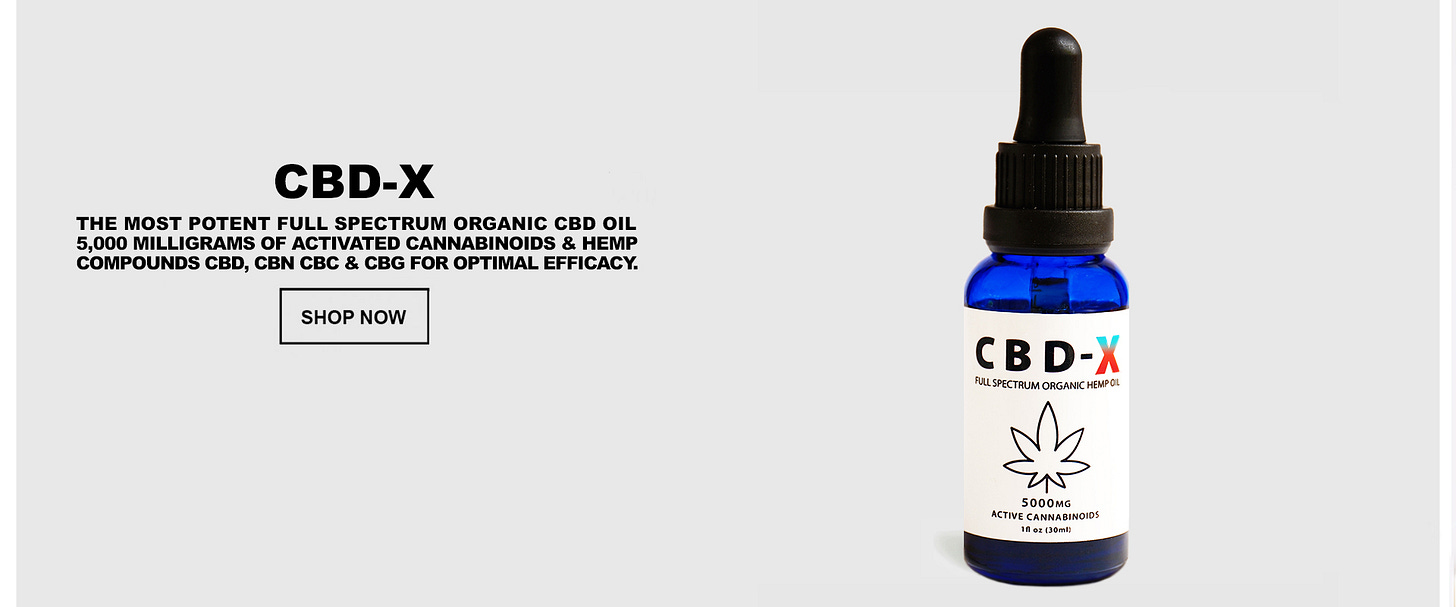Metabolic Therapies: Reclaiming Cancer’s Achilles’ Heel Through The Ivermectin, Fenbendazole, and Allulose Revolution
The Warburg effect — Otto Warburg’s seminal observation that cancer cells preferentially ferment glucose into lactate even in oxygen-rich conditions — represents a metabolic vulnerability ripe as the perfect therapeutic target for cancer treatment.
Yet, a century after its elucidation, oncology remains tethered to genetic paradigms, sidelining metabolic strategies in favor of cytotoxic and targeted interventions that work at best on about 15% of cancers, representing an abysmal “treatment” model.
Early anecdotal findings of thousands upon thousands of patients show that administering a synergistic combination therapy of repurposed miracle drugs across a large variety of cancers is efficacious in about 80%+ of patients, representing the all-elusive until now ‘holy grail’ cancer cure.
This willful neglect of the cure in plain sight, rooted in Rockefeller Eugenics, allopathic BigPharma, and industrial influences traceable to the early 20th century, has perpetuated a cancer “care” model that prioritizes profit over lives that is designed to relieve patients of the maximum amount of money en route to torturous iatrogenic outcomes, and/or being sent home to die.
Emerging metabolic therapies, including repurposed drugs like Ivermectin (IVM) and Fenbendazole (FBZ), alongside the rare sugar allulose, challenge this orthodoxy by directly targeting the glycolytic dependency of malignant cells. (Cancer cells are sugar dependent, whereas healthy cells use mostly oxygen to convert to energy stores.)
This highlights the Ivermectin Fenbendazole Allulose revolution sweeping the planet, with recent supply chain strains of IVM and FBZ from India due to huge increases in Worldwide demand.
Hundreds of thousands of late stage cancer prognoses are being declared full remission as borders across the world are doing there level best to seize IVM and FBZ on behalf of the corrupt governmental agencies that are bought and paid for by BigPharma and their Deep State partners-in-crime.
We will now explore the mechanisms underlying these agents (Ivermectin, Fenbendazole and Allulose) with Warburg’s insights, and their broader implications for cancer, type 2 diabetes, and obesity—conditions united by metabolic dysregulation.
The Warburg Effect: A Metabolic Blueprint
Warburg’s 1924 discovery delineated a stark contrast: healthy cells harness mitochondrial oxidative phosphorylation to yield 36 ATP molecules per glucose, whereas cancer cells rely on aerobic glycolysis, producing a mere 2 ATP while generating lactate. This inefficiency belies a strategic advantage—rapid ATP turnover and biosynthetic intermediates (e.g., nucleotides, lipids) fuel unchecked proliferation.
Warburg posited that mitochondrial dysfunction drives this shift, a hypothesis bolstered by modern research linking defective oxidative phosphorylation to cancer stem cell formation. This metabolic reprogramming is not a passive trait, but a linchpin of malignancy, offering a therapeutic fulcrum ignored by conventional oncology.
Ask most oncologists what the Warburg effect is, and they will tell you, “I have no idea.”
Ivermectin: Disrupting Cancer’s Metabolic Machinery
Ivermectin, a macrocyclic lactone traditionally deployed as an antiparasitic, has emerged as a potent metabolic modulator in preclinical cancer models. Its mechanisms are multifaceted, aligning with Warburg’s framework by targeting glycolysis-dependent pathways.
Studies demonstrate that IVM inhibits glucose uptake by downregulating GLUT1 transporters and hexokinase II (HKII), key enzymes in the glycolytic cascade.
This starves cancer cells of their primary fuel, inducing energy stress and apoptosis. Additionally, IVM disrupts microtubule dynamics halting mitotic spindle formation in rapidly dividing cells.
These activities do not materially impact healthy cells that rely on oxygen for its primary fuel, and as they are not rapidly dividing, disrupting the microtubular network does not impact them. (The opposite of chemotherapy, which indiscriminately destroys all cells, and ultimately poisons the patient.)
A critical dimension of IVM’s efficacy lies in its upregulation of p53, a tumor suppressor that orchestrates cell cycle arrest and apoptosis. By enhancing p53 expression, IVM amplifies the metabolic crisis in cancer cells, particularly Cancer Stem Cells, which rely on glycolysis for survival. (Note: the slow kill bioweapon C19 “vaccines” suppress p53, as well as genetically modifying the walking spike protein factory subjects with the highly carcinogenic SV40 promotor sequence.)
Preclinical data further suggest IVM modulates the Wnt/β-catenin pathway, a driver of Cancer Stem Cell self-renewal, offering a dual assault on tumor initiation and recurrence. Though human trials remain sparse, these findings—replicated across bladder, colorectal, and ovarian cancer lines—underscore IVM’s potential as a low-cost, repurposed metabolic weapon.
Fenbendazole: A Complementary Metabolic Saboteur
Fenbendazole, a benzimidazole anthelmintic used in veterinary medicine, complements IVM by targeting overlapping yet distinct metabolic vulnerabilities. Like IVM, FBZ inhibits glucose metabolism by suppressing GLUT1 expression and HKII activity, reducing lactate production and acidifying the tumor microenvironment.
Its microtubule-destabilizing properties mirror IVM’s, disrupting cytoskeletal integrity essential for cancer cell division. Unlike IVM, FBZ also impairs proteasomal function, amplifying cellular stress and triggering p53-mediated apoptosis in colorectal and lung cancer models.
FBZ’s efficacy perfectly aligns with Warburg’s thesis in its capacity to exploit cancer’s glycolytic (sugar) addiction; by curtailing glucose availability, FBZ forces malignant cells into a metabolic cul-de-sac, where compensatory mechanisms falter.
Preclinical studies highlight its efficacy against drug-resistant tumors, suggesting a role in overcoming the Cancer Stem Cell driven relapses that plague conventional therapies. While human pharmacokinetic data are limited — FBZ lacks FDA approval for human use (because BigPharma’s last remaining cash cow is cancer, and they are desperate to not approve these compounds) —its safety profile in animals and superabundant anecdotal reports fuel calls for rigorous clinical evaluation.
Allulose: The Rare Sugar with Metabolic Might
Allulose, a rare sugar found naturally in figs is a C-3 epimer of fructose, emerges as a novel adjunct in this metabolic triad.
Unlike glucose or fructose, allulose is minimally metabolized, evading glycolysis and exerting negligible impact on blood sugar—a boon for type 2 diabetes and obesity management, and radically safer than the scandalous Ozempic and Wegovy weight loss drugs now with class action lawsuits due to severe side effects.
Research illuminates its anticancer potential, aligning with Warburg’s emphasis on glucose deprivation.
In rodent models of diet-induced obesity, allulose supplementation reduces body weight gain while enhancing insulin sensitivity by upregulating hepatic glucokinase and suppressing lipogenesis.
These effects translate to cancer contexts, where allulose curtails glucose availability, starving glycolytic tumors.
Mechanistically, allulose inhibits intestinal glucose absorption and promotes urinary excretion, lowering systemic glucose levels without triggering insulin spikes.
This metabolic rerouting disrupts the fuel supply to cancer cells, amplifying the effects of both IVM and FBZ.
In type 2 diabetes, allulose’s attenuation of hyperglycemia mitigates the chronic inflammation and oxidative stress that exacerbate oncogenesis.
For obesity, its calorie-sparing profile — 70% sweeter than sucrose with 10% of the calories — offers a practical tool to combat metabolic syndrome, a known cancer risk factor.
Case reports of its integration into cancer protocols, though unpublished, suggest an added synergistic role in achieving remission, warranting further investigation.
Synergy and Systemic Implications
The confluence of IVM, FBZ, and allulose forms a metabolic trifecta that exploits Warburg’s insights with precision.
IVM and FBZ dismantle glycolysis and microtubule networks, while allulose deprives tumors of exogenous glucose, creating a hostile metabolic landscape for metastasizing cells.
This synergy extends beyond cancer: IVM’s FXR-mediated effects on glucose and lipid metabolism (Nature Communications, 2013) and allulose’s insulin-sensitizing properties address type 2 diabetes, while their combined impact on fat accumulation counters obesity. Preclinical models of triple-negative breast cancer demonstrate enhanced apoptosis when IVM is paired with checkpoint inhibitors hinting at broader integrative potential.
Yet, this approach confronts a familiar foe: systemic suppression. The Eugenic Rockefeller-led allopathic shift of the 1910s, detailed in prior analyses, prioritized patentable drugs over integrative therapies, a bias echoed in the sugar industry’s 1950s nutritional distortion (JAMA Internal Medicine, 2016) and the WHO’s mid-20th-century eugenic ventures under Brock Chisholm.
The 2020 dismissal of IVM for COVID-19, despite compelling preclinical promise, parallels this pattern: profit trumps science, or “Trust their Science.”
Pharmaceutical reluctance to fund trials for off-patent agents like IVM and FBZ, or unpatentable allulose, perpetuates their marginalization, leaving metabolic therapies in a limbo of anecdotal success and scientific neglect.
Historical Context: A Legacy of Metabolic Blindness
The Warburg effect’s obscurity is no accident, but a casualty of industrial agendas.
Rockefeller’s funding of the Eugenics Record Office and the WHO’s sterilization-laced tetanus vaccines in Kenya (1990s) reveal an indisputable through-line: science bent to serve control, profit and ultimately depopulation.
The sugar industry’s deflection of mendacious blame of fats resulted in a high-glucose dietary norm for Americans, fueling the obesity epidemic along with cancer’s metabolic engine all while burying Warburg’s warnings.
Today, oncology’s genetic fixation — bolstered by a 90% industry-funded trial landscape (JAMA, 2019) — mirrors this, sidelining metabolic strategies that threaten billion-dollar cytotoxics.
IVM, FBZ, and allulose, though potent, lack the commercial allure to shift this paradigm without concerted advocacy.
A Metabolic Renaissance: The IVM FBZ Allulose Revolution
Metabolic therapies like IVM, FBZ, and allulose offer a scientifically grounded counterpoint to oncology’s highly profitable deliberate failures.
By targeting aerobic glycolysis — cancer’s metabolic hallmark — they address the root biology Warburg illuminated, not merely its genetic symptoms.
Their applicability to type 2 diabetes and obesity underscores a unifying metabolic thread, challenging the siloed disease models of modern medicine.
Yet, their ascent demands a reckoning with a system that has, for over a century, favored profit over paradigm shifts.
For researchers and clinicians, the charge is clear: pursue rigorous trials, untainted by industry bias, to validate these agents.
For a scientific community attuned to history’s lessons, the Warburg effect’s revival could herald a new era of precision oncology—one that starves cancer at its source.
And the following may represent the ultimate Warburgian treatment protocol:
New & Improved Synergistic Joe Tippens Protocol
Tocotrienol and Tocopherol forms (all 8) of Vitamin E (400-800mg per day, 7 days a week). A product called Gamma E by Life Extension or Perfect E are both great.
Bio-Available Curcumin (600mg per day, 2 pills per day 7 days a week). A product called Theracurmin HP by Integrative Therapeutics is bioavailable.
Vitamin D (62.5 mcg [2500 IU] seven days a week).
CBD oil (1-2 droppers full [equal to 167 to 334 mg per day] under the tongue, 7 days a week) CBD-X: The most potent full spectrum organic CBD oil, with 5,000 milligrams of activated cannabinoids and hemp compounds CBD, CBN & CBG per serving.
Fenbendazole (300mg, 6 days a week) or in the case of severe turbo cancers up to 1 gram — for prophylaxis one 150mg tablet once or twice per week
Ivermectin (24mg, 7 days a week) or in the case of severe turbo cancers up to 1mg/kg/day — for prophylaxis one 12mg tablet once or twice per week
VIR-X immune support (2 capsules per day) — for prophylaxis 2 capsules per day
Removing sugars and carbohydrates (cancer food) from your diet and replacing table sugar with a zero glycemic index, zero calorie, keto friendly rare sugar like FLAV-X
The first step in achieving justice is to become as healthy and as hard to kill as possible.
MASS ARRESTS NOW.
Do NOT comply.








As I read about the figs what came to mind was the story of King Hezekiah (2 Kings 20:1-7) being so sick that he was near death but Isaiah directed ' "take a lump of figs." so they took and laid it on the boil, and he recovered.' v. 7
Isn't that interesting? The Bible also often talks about people dying/failing to thrive for "lack of knowledge" which I take to cover the whole range of life, material to spiritual.
There is little question Big Pharma knew ivermectin and many other drugs…cheap drugs ..were helpful to treat cancer….some had been used decades ago and which worked…yet they developed very expensive drugs up to $20, 000 per month!…but ivermectin was outlawed even for covid when it was allowed in India with HCQ with excellent results. I hope ivermectin like Arkansas make it over the counter!…seems oncologists only want to get kick-backs for using very expensive drugs?? Remember…likely current drug studies by big pharma are similar to that of the vac….and the fraud we now see of what was reported to consumers. and what they wanted to hide for 75 years